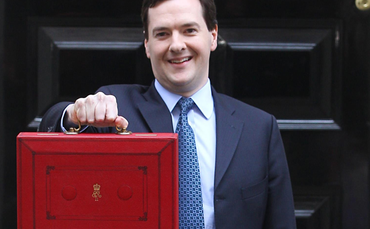 What can we learn about the future of fiscal squeeze in the UK (defined as substantial political effort to increase revenue or cut public spending or both) from looking at past cases? Is current or recent ‘austerity’ in a class of its own when we put it into historical perspective, or is it part of an evolving pattern?
What can we learn about the future of fiscal squeeze in the UK (defined as substantial political effort to increase revenue or cut public spending or both) from looking at past cases? Is current or recent ‘austerity’ in a class of its own when we put it into historical perspective, or is it part of an evolving pattern?
The table below identifies a total of twenty UK ‘squeeze’ episodes over a century (which can be qualitatively grouped together into roughly thirteen) in which revenue increased or public spending fell by a significant amount relative to GDP. We define a ‘hard squeeze’ as one in which revenue rose or spending fell both in absolute constant-price terms and relative to GDP, and a ‘soft squeeze’ as one in which revenue rose or spending fell on one of those measures but not the other. The table also records the variety of governments involved in squeezing (right or left, coalition, majority-party, minority), the delegation or otherwise of economic policy functions or decision advice relating to interest rate setting, consideration of spending economies, and financial/economic forecasting.
Of course, deriving consistent data series from historical statistics over a hundred years is far from problem-free, so we should not try to read too much into small differences. And two of those thirteen episodes occurred during the special circumstances of the two twentieth-century world wars, involving very sharp revenue squeezes together with cuts in civilian spending to fund a huge blowout in military spending when party electoral competition was largely suspended. But even allowing for such issues, three changes over time stand out from this analysis.
One is the notable disappearance in recent decades of the ‘hard revenue’ squeeze, once a common feature of earlier episodes (and often preceding later spending squeezes), but not occurring in the UK since the early 1980s. Indeed, our comparative study of fiscal squeezes across nine democracies in different times and places (The Politics of Fiscal Squeeze, OUP/British Academy 2014), indicated that revenue-led squeezes seemed to be remarkably rare. So what accounts for the apparent disappearance of the hard revenue squeeze from the recent set of fiscal squeezes, and is it a disappearance that is likely to continue or to be reversed in the future?
A second is the absence of ‘cutback commissions’ or outside bailouts in the UK since the 1970s. As the table notes, there has been notable variety over time in the extent and types of delegation of financial and economic functions to bodies outside direct ministerial control, as with the task of deciding central bank interest rates since 1997 and economic forecasting since 2010. Over the whole century there has only been one emergency government set up specifically to apply fiscal squeeze (the Ramsay MacDonald ‘National Government’ of September 1931). Nor (in contrast with recent Eurozone experience) has there been a fiscal squeeze in the UK since the 1970s that was part of a negotiated financial bailout by outside lenders. And it is notable that at a time when delegation of functions has commonly occurred in other fields of policy for reasons of efficiency or blame-avoidance, there has been no ‘cutback commission’ handed the poisoned chalice of recommending which areas of public spending should be cut and by how much, since the Geddes Committee of 1921-2 and the May Committee of 1931 (whose terms of reference were copied from those of the Geddes Committee).
Is that another approach to fiscal squeeze that is gone for good, or might it be expected to recur in some circumstances? Can the disadvantages of using such an approach (for example that published reports can exacerbate the financial market crises they are intended to help stave off, or that committees may split after a long period of deliberation, both of which certainly applied to the 1931 May Committee) always be expected to outweigh their potential advantages?
A third change that stands out from the table, possibly related to the second, is an apparent shift from short-and-sharp spending squeezes in the early decades of twentieth century to more long- drawn-out spending squeezes with lower annual spending reductions in more recent times. Indeed, most of the spending squeezes for the last sixty years have been ‘soft’ squeezes. What accounts for that change? Does it reflect a changed position relative to financial and currency markets, as compared with earlier periods in the century? Might the explanation be more political, for example in the dominance of fiscal squeezes led by right-of-centre governments since the 1970s or of the use of electoral tactics such as those employed by the Conservatives in the 1990s (repeated in the 2010s) of challenging the Labour opposition to pledge to match its ambitious proposed spending cuts in the future (or face election-campaign accusations of secretly planning a ‘tax bombshell’)? Or is there something about the way that modern state spending is set up (for example through long-term contracts with private suppliers, or through its changing composition across policy domains) that makes it harder than it might have been in the past to put the brakes on quickly?
If the future of fiscal squeeze follows the pattern of the past, we can expect future squeezes to continue to bite harder on the spending than on the revenue element, to be orchestrated and planned within the central administrative apparatus rather than by outside commissions, and for the pain to be spread over longer periods with lower annual falls, rather than in sudden steep cuts. But there are well-known dangers in basing forecasts about the future from what we can see in the rear-view mirror. Some or all of those apparently discarded approaches may be due to reappear, especially if there are any good reasons for supposing the political and economic future might turn out to be more like that of the 1920s and 1930s than of more recent decades.
Table 1: UK Fiscal Squeeze Episodes 1916-2014: Extent, Type, Decision-Making Process









No Comment